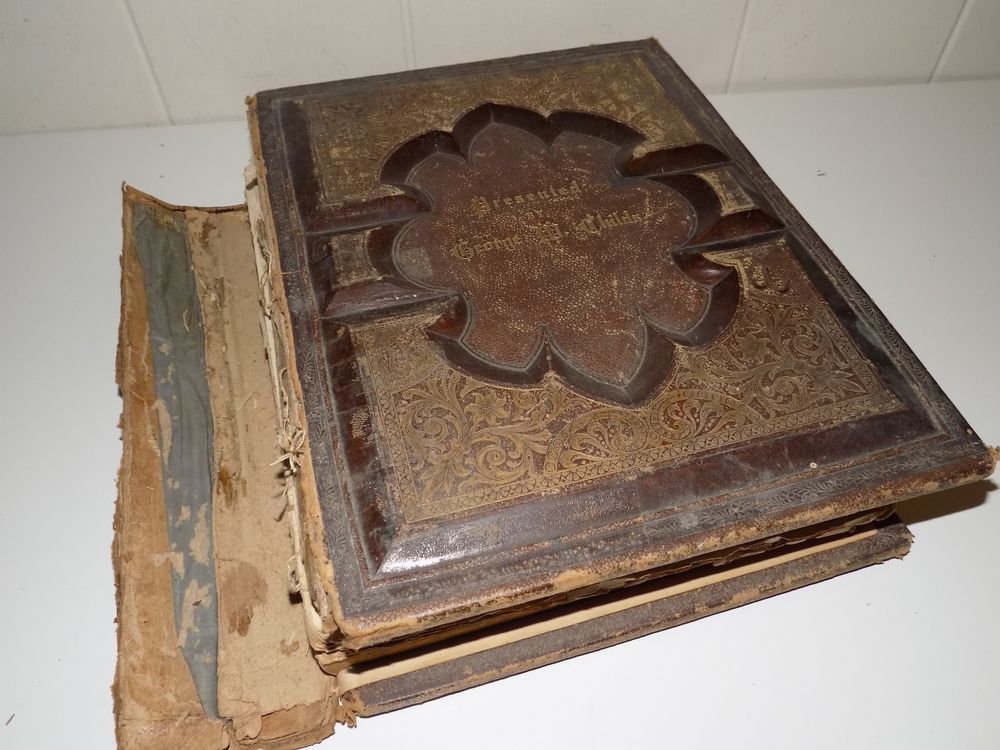I have a regally appointed Bible published in 1873 by the American Publishing Company of New York. It contains both Old and New Testaments, along with some 600 engravings. The book is 13 x 10 x 4 with water stains n some, but not all of the pages. The cover is detached and masking tape was once used for repairs.
Family Bible from 1873
I’m more interested in restoring this Bible than in having it appraised. My father left it to my son and I’d like to have it restored before my son passes it to my now three-month old grandson. Any information you have would be appreciated.
I’ve always found that books make a home. I’ve dragged cartons of them across country and shipped even more. In general books are affordable, sturdy and easy to pack. Books run the gamut from rare 1st editions to the board books we teethed on. Many are cherished parts of a family heritage.
Historically, if a home could afford only one book that book was a Bible. Family events such as births, deaths, weddings and christenings were recorded by hand on the inside covers; notes, locks of hair and pressed flowers were pressed in their pages. Bibles stand as a tangible symbol of family and faith.
So, although a Bible or any other book could have been printed centuries ago, old Bibles usually have very little monetary value. Many were inexpensive to begin with and sunlight, damp, insects and regular reading can damage bindings, covers and pages. Restoration does not make monetary sense.
But restoring a family Bible for future generations is always a fine idea.
Klaus Rotzcher, owner of Berkeley’s Pettingell Book Bindery
I was able to visit Klaus Rotzcher, owner of Berkeley’s Pettingell Book Bindery, for insights. His shop in Berkeley has the old world feel of a museum: many of his tools are well over a century old and irreplaceable. Klaus is a German University trained master bookbinder who has worked at the craft for four decades. His hand bindings are custom, unique and will last for generations.
Klaus explained that he has 22 distinct steps to binding a book. When restoring a binding he always aims to work with what is left of the old binding and to maintain the integrity and the esthetic of the original appearance. He preserves as much of the old binding cover as possible; determines what approach will be right for the book; works with the owner to choose boards, end papers, covers, spines, stitching styles, and ornamentation. He has vast selections of paper, cloth and leather as well as a collection of more than 50 printing fonts. As a master craftsman, he has the insight, experience and understanding of books that make the painstaking process of breathing life back into an heirloom possible.
Klaus also shared some tips for protecting your books: the weakest point of a book is where the cover meets the spine. So as not to stress the spine, when you read a heavy book always open to the center pages and then page to where you want to read. Don’t pull books off shelves by the spine! Keep your books away from damp or excessive sunlight. Protect leather bindings by occasionally wiping shoe polish or leather preservative. A restored binding will last for generations.
The craft of hand printing and bookbinding has not changed much since Gutenberg published his moveable type Bible in the mid-15th century. While computers, offset printers and massive presses have changed the industry of printed documents, it’s always nice to know that careful, custom craft is still available.
For more information visit:
Pettingell Book Bindery in Berkeley - www.petingellbookbindery.com
San Francisco Center for the Book - www.sfcb.org
American Bookbinders Museum in San Francisco - www.bookbindersmuseum.org
North Bennet Street School in Boston - www.nbss.edu




